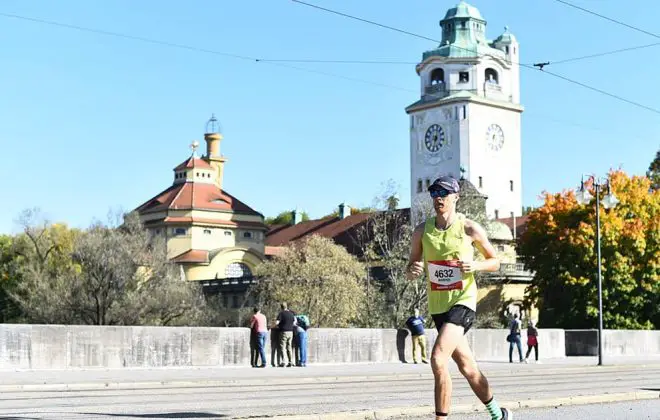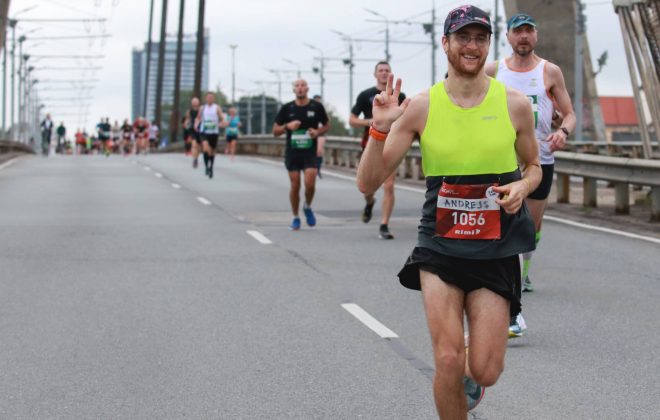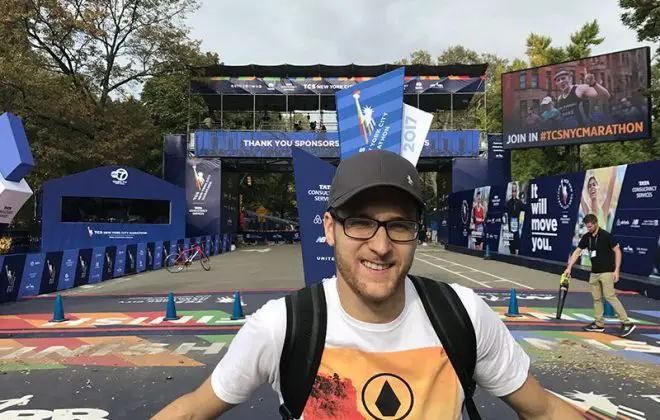Munich Marathon Race Review – My First Marathon Experience
It was 6:00am on a cold Sunday morning in early October. I was up from bed and ready to smash my first marathon.
However, not everything goes as planned on race days. But more on that a bit later.
Running 42.195km has long been on my bucket list, yet being a professional kayaker I never had the opportunity to take the time out to do it. Finally, though, the day has come for me to have that experience and I chose Munich Marathon to be the first one.
The first part of this post is all about my first marathon experience, emotions and training. If you’re here for the race review – scroll down to the second part.
It’s all in the head
Legend has it that a Greek messenger Pheidippides ran a distance of ~40km from the city of Marathon to Athens to announce Persians’ defeat. I remember reading that part of the history of Ancient Greece and becoming inspired to repeat such endurance challenge.
I was very determined to bring that legend to life someday.
But I didn’t have any message to bring. Instead, I wanted the thrill of running my first marathon. I was curious to know how does it feel to run for that long without stopping. Or what is my pain threshold and if I can resist the temptation to stop or walk.
There is also a saying that I always wanted to test:
The best thing you can do for your body is to prepare for a marathon. The worst thing – to actually run it.
I was curious about the first part and not taking seriously that last bit.
So, I’ve relied on experience and knowledge from my kayaking background on how the body functions and drafted a training program for myself. I also documented my thinking behind it and the process in a series of post on this blog as well.
The effect this whole journey had on me was amazing. It didn’t just structure what I already knew, but, as I analyzed my progress, I learned even more.
In fact, there are so many emotions and information I’d like to share that this is going to be a long post. Grab a pot of tea and let’s roll.
View this post on InstagramA post shared by Andrejs (@theathleteblog) on
Race day
So, back to that cold Sunday morning.
I couldn’t figure out what to wear until the very last minute. It was my first marathon and I wan’t sure how my body will hold for what I expected to be 3+ hours.
To simplify logistics I picked the race in the city I live in, which should have minimized clothing choices and other issues. That was the theory.
On one side it was a cold morning and the forecast for the day was just several degrees above freezing. On the other hand, I would be running and will warm up eventually.
Tough choices.
Using all my knowledge of physics, meteorology and aerodynamics, I came up with a brilliant idea. At least it felt like one.
I ended up dressing like a scuba diver. The only thing I was missing was an oxygen tank behind my back.
Eins, zwei, Fashion Polizei.
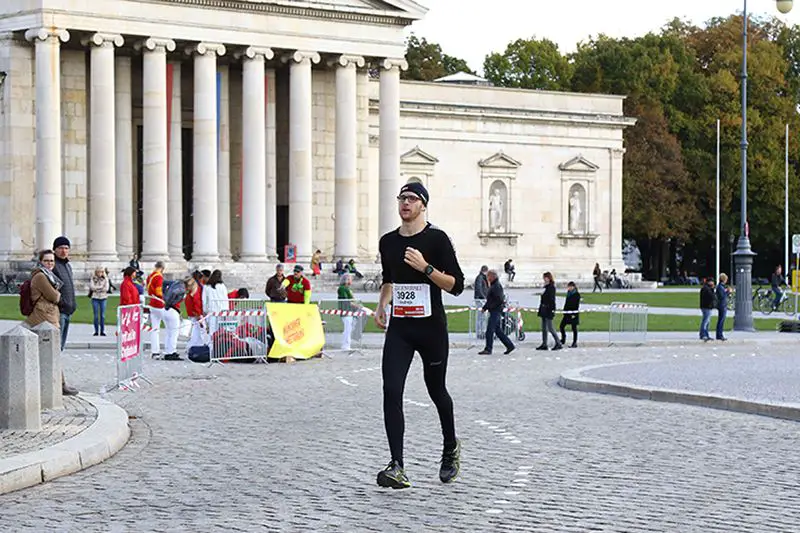
The bigger concern I had was pacing. I had no experience or reference for how to pace myself. Nor could I predict how my body would respond. I planned to run by feel, but keep an eye on the heart rate to keep it around 10-15 beats lower my threshold to be on the safe side. It should’ve given me enough reserves for the second half.
The idea was good, the execution – quite poor.
My first marathon experience
From the start I felt quick and very light (thanks to a good taper). The first part felt easy, in fact, just like a training run. But it all started going downhill shortly after the half point. That was when I really felt I was crashing:
5 km – Fly like a butterfly, sting like a bee. Bring it on!
10 km – speed seems right, people around me are nice, the weather is nice – all is right in the world. Heart rate is a bit high, but I can’t drop the pace just yet, I’ve already made friends with that old guy in orange shirt
14 km – brunch time, food station. Picked up a gel, took me a whole kilometer to swallow it fully. ‘Dropped’ the pace a bit just to stay on the safe side
17 km – oops, seems like a long hill ahead. Old guy in orange shirt went ahead. I guess it’s age before beauty this time
18 km – oh god, still climbing
21 km – half-marathon, 1:32 going strong. Half to go – no problemo, I can do this. My breathing is a bit hard, but hey – muscles still seem to function well
24 km – ok, what happened in the last 3km? I was descending – that should be easy. My legs are getting stiff, I should drop the pace a bit
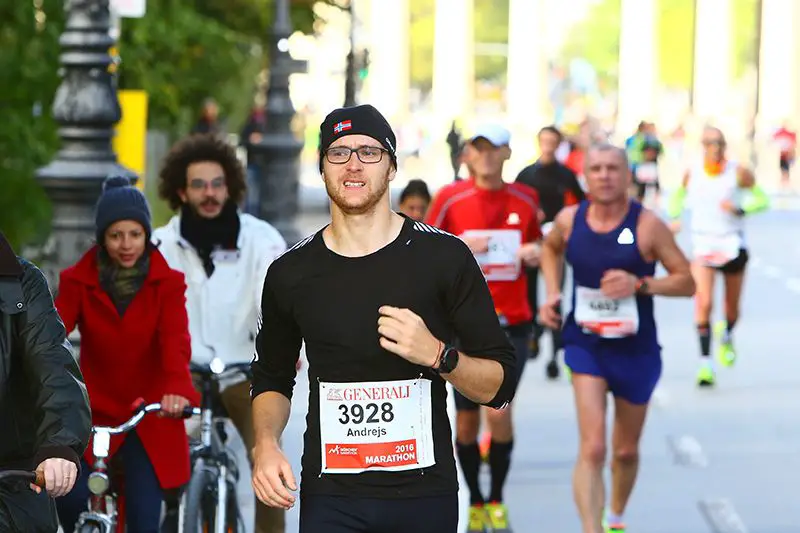
26km – let’s drop it just a tiny bit more, that will not hurt anyone. Staying optimistic
28 km – food station, lunch time. Picked up 2 gels instead of one. Great success
29 km – both gels out, no improvement.
I start to remember how I used to think “what is this wall everybody keep talking about? After 32km it’s just another 10K and you’re there”. So young and so naive…
32 km – there’s no way I can run 10 more kilometers. I can barely count how many is left until the next water station
By this time I understood that it’s gonna be a real battle to the finish. Not against competitors, but against the violent brotherhood of pain and fatigue. I was loosing speed. Big time. My pace already dropped from 4:20 to 4:50 and the outlook was not in my favor.
33 km – hey, there’s my family – keep cool, show no sign of fatigue 🙂
37 km – 5K to go. I remembered thinking before “hey, 5K is nothing, I can run that in any condition”. The universe was probably like “mmmm, let’s see about that”.
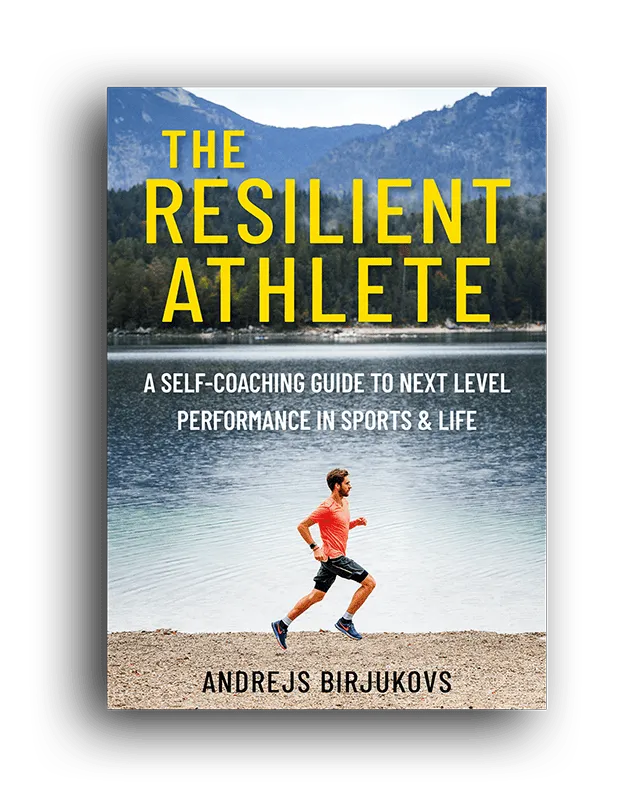
The Resilient Athlete
A Self-Coaching Guide to Next Level Performance in Sports & Life
Are you aiming to become a resilient athlete who is able to withstand any pressure? Be able to jump on any opportunity? Take any challenge life throws at you head on?
Then this book is for you.
Learn moreMy legs started to hurt very much at this point. I mean, they were stiff before, they were tired, yes, but they didn’t hurt. Now with every step, the side of my leg (IT band) was in serious pain and I grew increasingly concerned about the next 25 minutes of suffering.
40 km – pain is somewhere there, but I don’t really feel it that much anymore. My legs are like two Belgian waffles. Mmmm, waffles… I don’t feel my knees actually bend, I just feel the impact on the road and the pain. It’s not about the legs, it’s all in your head
I saw this poster around 10K that kept me going throughout the race. It said
First 20K you run with your legs, next 20K you run with your mind, last 2.195K you run with your heart.
At this point I felt enlightened and the message became very clear to me. My legs hurt, my mind was playing tricks on me all along and only the heart said “come on, you can do it”.
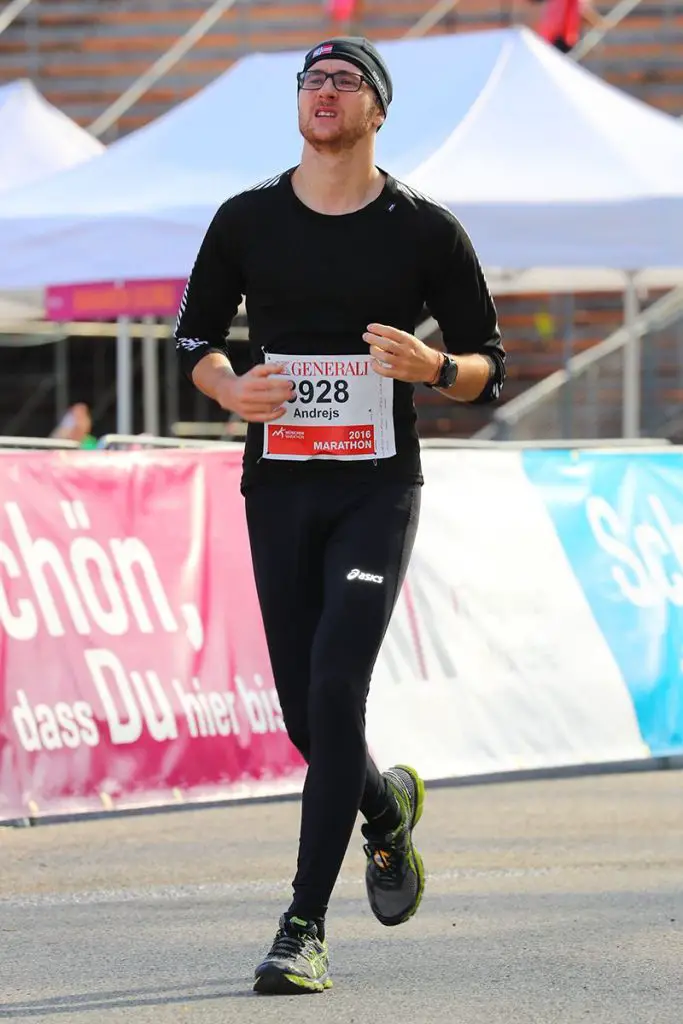
Stadium. Final lap. Finish – 3:19:40.
My first marathon result
3:19 isn’t bad, but I felt it was far from optimal. My second half split was 17 (!!) minutes slower – talk about bad pacing.
I should have started more conservatively and kept at least 4:30min/km (if not slower) for the first half and see where I am. It would save me a lot of effort I really needed at the end.
It’s like with a car – going slower is more economic.
I didn’t have an exact time goal, though I tried to pace myself thinking what speed I can ‘technically’ sustain. That was a mistake and led to a real mental struggle at the end.
I promised myself I will not walk, despite how badly I would want to. At every aid station my inner voice said “come on, just walk 100m, that’s not going to do any harm” and it was really hard to resist it.
As I saw it, the problem with walking (if you are forced to do it) is that once you start doing it it’s so much harder and painful to resume running again.
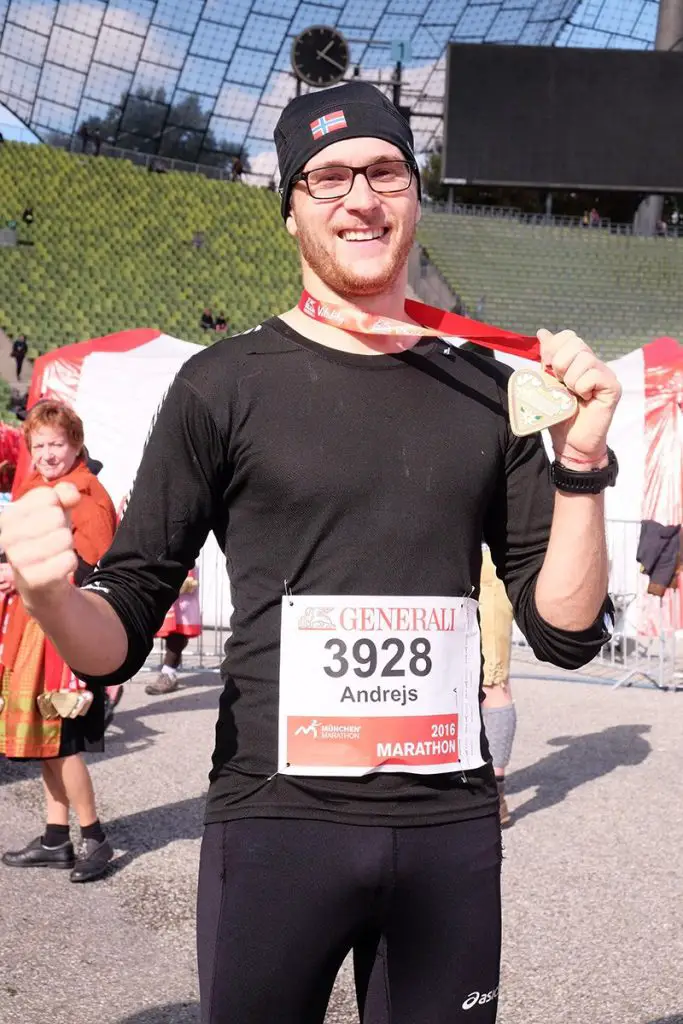
I remember thinking right after crossing the finish line – no more marathons. That was a good experience, but enough is enough. To be honest, now that the time has passed and I’ve analyzed it – I want more. I want to do it better. There’s so much to be improved and I’m interested to see how that turns out.
Related: NYC Marathon Race Report – Running My Dream Race
So, what did I do wrong?
In short, I set myself up for a very painful second half in the first 5K of the race. It was my first marathon and I didn’t expect what kind of impact the distance will have on the body.
In short, I got too excited and started too fast.
It actually felt easy at first, but I confused it with the freshness I had from the taper. In reality, I should’ve kept the conversational or at least a moderate pace until at least the halfway point. Instead, my heart rate was in Zone 4 already within 3K of the marathon. No wonder I had no power left to pick up for the last 10K.
Related: 5 Heart Rate Training Zones – Guide To Maximum Endurance Gains
At 14K it got harder, but I still carried on. The hill at 17K made me slow down a bit and took more power out of my legs, but at HM mark I looked at the watch and tried to pick up the pace and regain what I lost by slowing down going up the hill.
I didn’t have any experience of racing 2+ hours, so didn’t know that feeling good at halfway doesn’t mean anything.
At 22K during a long descent I realized my legs are getting heavy and pace started to drop first to 4:35 and then even slower. I began to feel fatigue and at around 30 km it started to become bad.
I was basically counting kilometers between drinking stations and having 2 glasses of water/iso drink at each one.
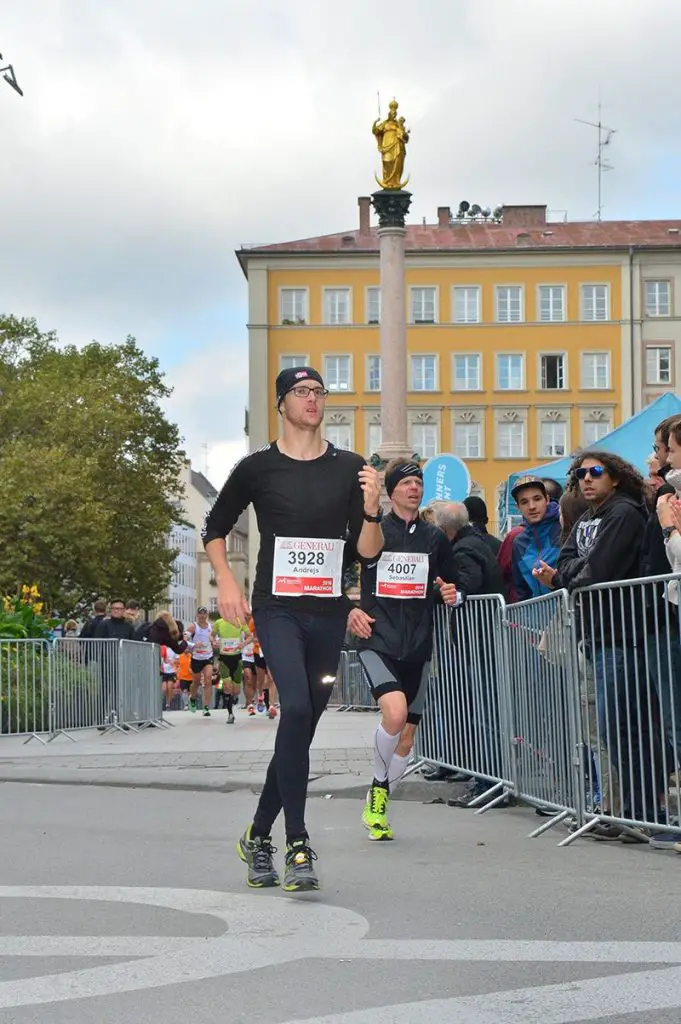
Last 10K was about winning over the pain. Everything in my body said I should stop and rest.
But I did make a promise that under no circumstances will it come down to walking or stopping. I knew my first marathon will be hard physically and mentally and that’s what I signed up for. I did it and am super proud of that.
How did I train for my first marathon
As mentioned, I drafted the program for my first marathon myself. It didn’t change much as the race got closer and generally worked pretty well. I felt gradual increase in the average running speed for the same effort and that was enough for me.
I started with a lot of base training in spring. Lots of easy running focused on improving form, economy and general endurance. Throughout summer I started gradually adding tempo and speed workouts to build leg strength and improve the “cruising” speed. And that was it.
Related: First Time Marathoners – 18 Training, Taper & Race Day Tips
I started with around 3 runs/week and built up to 5 runs/week in the end. During the whole process the main workout for me was the long run which went up from ~10K in the winter to a couple of 30-32K runs a month before the marathon.
One thing I may have neglected in my training program was the strength training. Some advise against it, but I think strength & conditioning helps to maintain power and form for longer.
I have documented my training progress, as well as what I’ve learned, through a series of blog posts below:
- 4 Main Benefits Of Aerobic Base Training For Marathon Runners
- Early Morning Training – Athlete’s Secret Time Management Weapon
- 5 Core Exercises For Runners To Get Fast & Stay Injury-Free
- How To Overcome Running Fatigue While Training For A Marathon
- Marathon Strength Training – 4 Sessions To Build Power And Endurance
- Full Body Dynamic Pre-Run Warm Up To Improve Performance
- Marathon Long Run Variations – 5 Sessions To Boost Endurance Gains
- Marathon Taper Tips And My 2 Week Marathon Taper Schedule
Did you find this information useful? Share the post with others using the buttons below.
Munich Marathon Race Review
I may be slightly biased in my review (this being my first marathon), but judging from my competitive experience the race was organized really well.
Munich marathon takes place on the second Sunday of October. That’s usually a week after Oktoberfest – the traditional Bavarian beer festival lasting 3 weeks.
Not sure if it’s done on purpose or not, but I can imagine it can be hard to resist a beer or two for someone who comes a week early.
October is usually warm in South Germany, but the weather on race morning can be rather chilly (a couple degrees above freezing). It will warm up later in the day (in my case to around 12 degrees), which is more comfortable for running. I ran the whole marathon in tights and long sleeve shirt and after 10K regretted having so much clothes on.
Munich Marathon course & elevation
The course hasn’t changed throughout the last couple of years. It was the same in 2014/2015 and only minor changes planned for 2019. Start and finish of the race are in the Olympic park, but the finish, actually, takes place in the Olympic stadium.
It’s a one lap course, which is a great bonus.
The Munich Marathon course will take you through the city center and the famous park – the English Garden, which in some places feels like a forest.
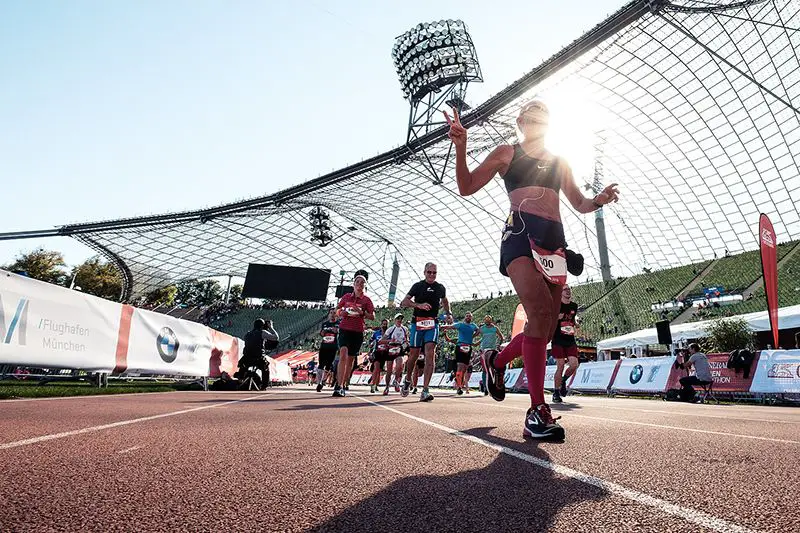
First 5-7K of the course will take you through the streets of Munich and get you in the English Garden.
It’s good that the park is early in the race. It’s rather long (~10K) and, at least to me, is a bit boring. Also, there are less spectators & cheering there.
Once you’re out of the park – beware. There is long hill (around 2 kilometers) that takes quite a lot of energy. I always kept thinking it would end soon, so didn’t drop the pace that much. Don’t do that.
At the top of the hill the fun part starts. Bands are playing, people dancing and, as you’ll be approaching HM mark, more and more people will cheer for you. The whole atmosphere was much more exciting than in the park.
After the HM mark the course goes down (for a kilometer or so) and has a few lonely turns before you see spectators again.
At around 28 kilometer mark you run into the very center of the city. It takes you through the central square (Marienplatz) where most of the audience is. At this part of the race the atmosphere is amazing.
You have your first name printed on the number and many people call your name and encourage you to keep going.
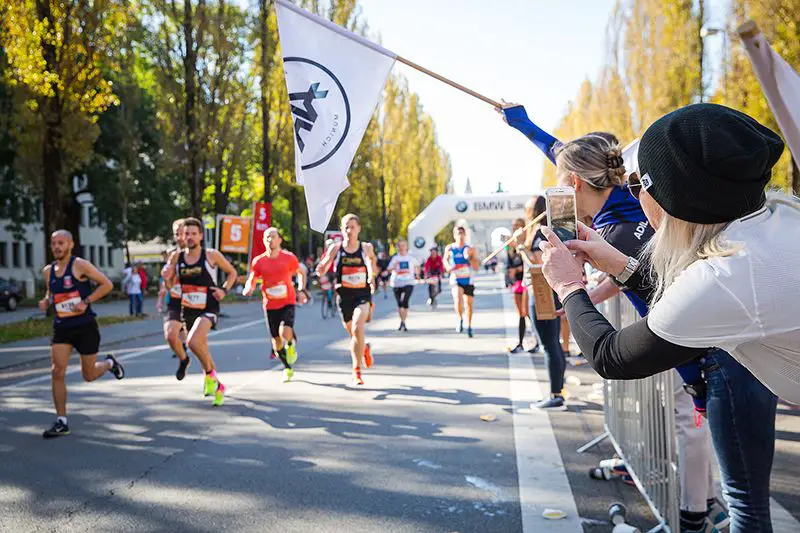
Last 4K kilometers, are quite lonely, unfortunately. You run the same path back to the Olympic park and, as most of the spectators are in the city center, only locals who went for a walk will cheer for you. Final kilometers before you get to the Olympic stadium you are on your own, literally. There is nobody, except fellow runners, cheering for you.
The total race elevation is not that big – only 90 meters in total (difficult NYC marathon course has ~280m and flat Berlin course ~65m). The problem is that most of this elevation comes at the hill around 17K where it’s still early enough to overcook yourself. While you’re fresh it’s better to slow down.
Fueling and pacers
As in most marathons pacers are there for finish times of 3:00, 3:15, 3:30 and so on. You can always estimate where you are even without a GPS device on you.
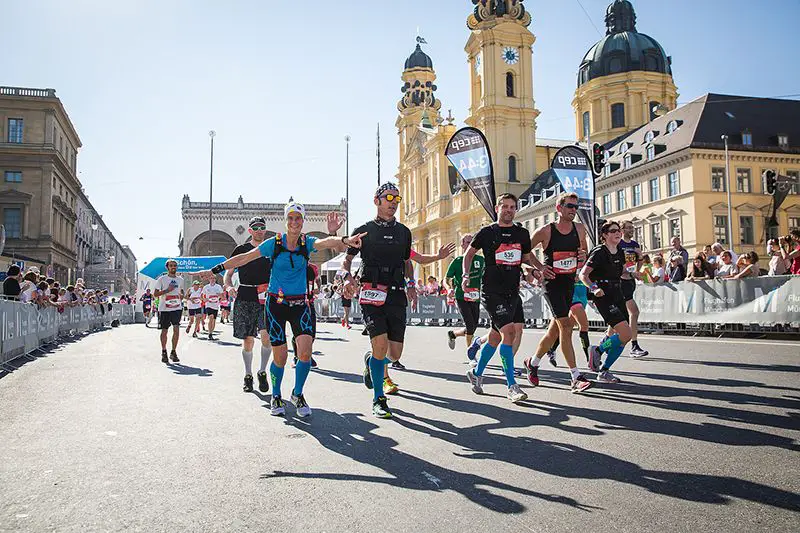
The fueling during the race was great. After the first 5K there were water stations and iso drink stations every 2.5 – 3 kilometers (first station with water, next one with iso drink). Additionally, gels are handed out at 14 and 28 kilometers. After 28K mark, every second station will also have energy bars and bananas (both split in pieces).
Post-race extravaganza
Once you cross the finish line and got your finisher’s medal – you’re in paradise. Or a candy shop. Or both. There are tons of all-you-can-drink fluids (water, juice, protein milk, alcohol-free beer) and lots of food and snacks (cakes, protein and fitness bars, bread). I didn’t stay there for as long as I would want to, however. Just enough to drink a bit and eat some cakes to get some strength before handing in my chip and getting out.
If you want to stay longer, though – you can get some blankets to cover yourself from the wind and have a nice party there.
Once ready to go, there is just one tiny thing remaining. The finish is below the stadium entry point, so to get out you will need to walk up the stairs.
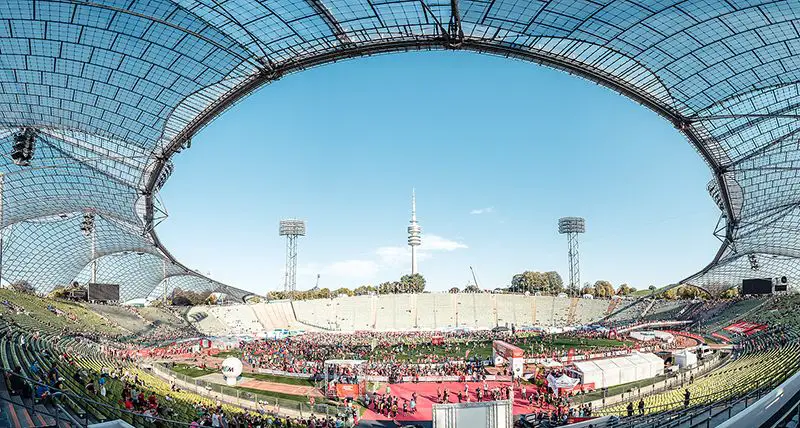
One last thing. Approximately 1 week after your race you’ll get an email with a link to your photos. Turned out they took pictures of all runners throughout the race. With a software they tagged each picture to runners’ numbers and sell packs of photos and finish video for 10 – 15 euros.
The verdict
Overall, I couldn’t ask for a better first marathon experience. The organization was great. Spectators were very active and encouraging. The course was interesting. And even despite my problems with pacing and suffering in the end it was all I expected such challenge would be.
I would definitely come back to this course for more.
Have an opinion? Share via links below and tag @theathleteblog
Tags In
Andrejs Birjukovs
GET A FREE TRAINING PLAN
Subscribe to my email list and get access to a free 4-week “back in shape” training plan
You’ll also get two full-body strength sessions and some other goodies!
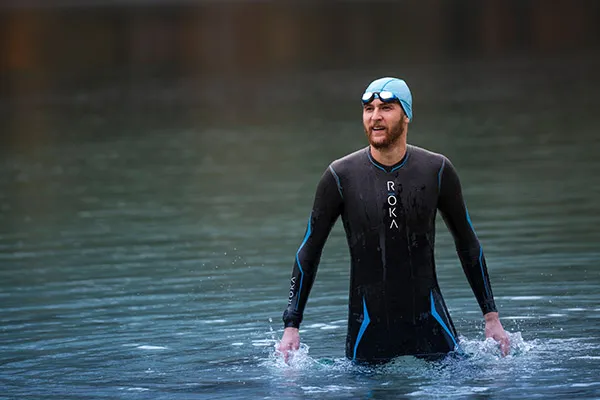
How did I get here?
Hey there! My name is Andrejs and I am here to inspire, entertain and get you fit for any adventure.
I went from being an over trained pro athlete to an endurance coach sharing how to listen to your body and live life to the fullest.
Traveling, new sports & activities brought new meaning to my training and made it much more effective, fun and enjoyable. And I'm here to help you do the same.
